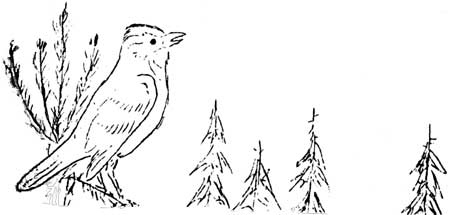VARIOUS WAYS OF SOLVING THE WINTER FOOD SUPPLY PROBLEM.
It is very interesting to observe the various methods used by the
wild animals in solving the problem of limited food supply which comes
with the heavy snows and extreme cold of winter.
No fruits ripen in winter, no fresh green herbage is found, birds and
small animals are not so numerous, and the heavy snows cover the face of
the earth. Winter is indeed famine time for the wild animals, and
without some change in their habits of life they would certainly suffer
extremely.
The grazing animals migrate with the coming of winter to lower
altitudes where less snow falls and the herbage is therefore more easily
secured. Goat migrate from the high meadows at timberline to the upper
edge of the forests and select the sheltered side of cliffs where the
snow never becomes very deep. The deer and elk migrate from the high
meadows to the lower river valleys and find ample food in the willow and
alder thickets of the dense forests.
Predatory animals migrate with the game animals. The wolves and
mountain lions follow the bands of deer and elk and the coyotte and wild
cats move to the low country as soon as the birds and smaller animals of
the high country disappear. In the woods they find a great many
snowshoe rabbits and grouse.
Many of the smaller birds migrate to the far south and there under
sunny skies they continue under summer conditions.
Certain of the smaller animals have well developed storage instincts
and all summer long are busy laying up a supply of food for the
unfruitful months of winter.
The little cony or rock rabbit is busy all summer thru gathering hay
and piling it in neat little haycocks on the rock slides to cure in the
sun. Later he carries it beneath the rocks and is active and well fed
all winter.
The sewell or mountain beaver also makes little stacks of edible
herbage at the door of his burrow or stores it in special haymows
prepared for that purpose beneath the ground.
The pack rat stores his supplies in caves, hollow logs and deserted
cabins and the Douglas squirrel lays up great caches of cones wherever
he can find a dry place.
Field mice that live in the moist grassy meadows make great spreading
networks of dunnels beneath the snow and in that way reach the dry grass
and roots, and the bark of the shrubs and trees.
The beaver cuts billets of wood and branches of trees and sink them
beneath the water so even tho the pond may be covered with ice they have
access to their storehouse.
Perhaps the most interesting and novel method of all, however, is
that employed by the chipmunks, ground squirrels, marmots, and bears.
This is hibernation. They solve the problem by ignoring it. When the
cold hungry days come they simply select a safe hiding place, curl up
and sleep until the balmy days of spring. It is a clever method but one
marvels how it is possible to go that long without food and drink.
The ground squirrel actually freezes up. He becomes rigid but thaws
out nicely in the spring none the worse for the ordeal. The chipmunk
sleeps lightly and occasionally on warm sunny days he peeps out only to
return to his nest again at the first drop in temperature.
The bears about Longmire usually seek their hollow-tree dens soon
after the first of December and sometimes are not seen again until well
into April. Four months of blissful sleep. In the spring they usually
appear as sleek and fat as if they had been well fed all the time. The
secret lies in the fact that during the period of hibernation the bodily
functions all but cease. Heart action is barely perceptable and
respiration becomes very slow and light. Digestion of course ceases
entirely.
SPRING IS HERE.
Robins are back. Varied thrushes are whistling from the tree tops.
Jays are building nests. Snowshoe rabbits are changing their coats.
Skunk cabbage is blooming. Elderberry bushes are budding. Warm breezes
blow. It can mean nothing else.


